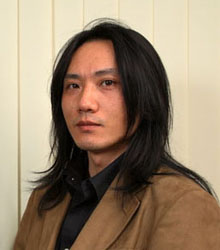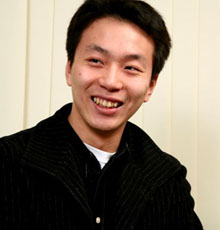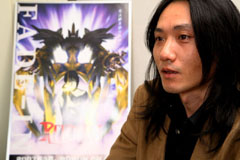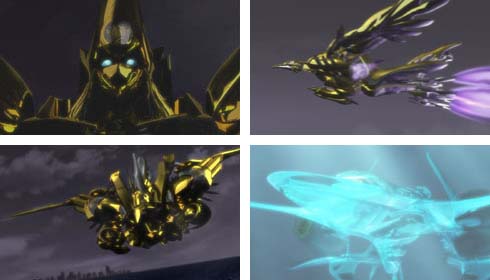A Golden Light in the Dark: The Making of Reideen CG Animation (1)
Mitsuru Hongo's Reideen inherited the DNA of Reideen the Brave, the animated classic that aired on Japanese TV between 1975 and 1976. But at the same time, it returned as an entirely new Reideen with refined mechanical designs and settings. Furthermore, the new series features high-quality 3D CG animation that was unthinkable for a TV production until now. Shigeki Hayashi and Keiji Ikeda were responsible for the modeling and VFX of Reideen and the Self Defence Police. In the first of this exclusive four-part interview, they reveal how they came to participate in the project and their impressions at the very early days of the production process.
 | Profile: Shigeki Hayashi - Born on January 26th in Chiba Prefecture. 3D CGI director. Board member of SimImage Studio. While still at school, he was convinced that CG was going to be the indispensable technology for the future film industry, and he decided to become a CG creator. The first creative work was to make a film that was shown at Fujitsu's pavilion at the 1990 International Garden and Greenery Exposition held in Osaka. After working for Polygon Pictures, he landed a job as lighting artist for the 3D CG movie, Final Fantasy (2001), and continued to participate in several projects including SD Gundam Force (2004, TV series, animator), in the game Monster Hunters (2004, movie part, animatics director) and Zoids: Genesis (2005, TV series, 3D CGI director). On Reideen he comments, "It was a venture to challenge the limits of 3D CG in a TV series." |
 | Profile: Keiji Ikeda - Born on October 31, 1980 in Okayama Prefecture. 3D CG VFX designer. He decided to work in the CG visuals industry because he wished to share what he enjoyed the most as a child. In 2004, he debuted as a CG designer with a TV ad for Pocket Monster Emerald (Game Boy Advance software.) Since then he has worked on Gundam Evolve (full 3D CG OVA, 2001 to 2003) and the game Monster Hunter 2 (2006). He is one of Japan's promising young CG creators. On Reideen he comments, "Yeah, it definitely was a challenging project." |
Reideen has everything we wanted to express with 3D CG.
First of all, can you tell us how you happened to join the Reideen team, Hayashi-san?
Hayashi: A sales representative from Maya introduced me to Producer Eiji Mizutani, who is the head of IGFX, Production IG's 3D CG studio. At the time, I was working as CGI technical director in Zoids: Genesis, so I think it was towards the end of March 2006 when I joined the Reideen team. The production had already advanced to some extent, so I took over from there.
Zoids: Genesis and Reideen both have CG animated mechs. Were there any techniques and know-how from Zoids: Genesis that you found helpful in Reideen?
Hayashi: From my previous experiences with TV animation, I learned that how we structure the workflow was very important. I made improvements to a workflow I created for Zoids: Genesis and used it for Reideen. In a 3D CG production, the created data goes through several people's hands. It's fundamental that you don't get things messed up in that process. You should also let the computer do as much as it can, so that you can concentrate on adding animation and creating visual effects. I aimed at making a work environment where the staff could concentrate on their job and could also see the entire production workflow at a glance.
As for the modeling, we created everything from the scratch. For the motion graphics, in Zoids: Genesis we were able to reuse movement data for different Zoid models just by changing the camera settings to get different shots, but for Reideen, the main concept for the movements was "slow," so we couldn't reuse the data, except as for some walking sequences for the Jinrai.

"Slow" movements are the trademark of this series, and were never used in a previous robot anime. What was your first impression when you heard Hongo-san's idea?
Hayashi: By coincidence, I wanted to make that kind of robot anime, too, so I was really hooked on that process. Director Hongo also requested that we should try to avoid cel-shading (*) and outlines. I had that idea too, although I knew it was very risky. It meant a challenge for me, but I was very positive about it. It was so amazing that I even start feeling worried: was I really allowed to load this project with my ideas since the very beginning? (lol) (1)
Ikeda-san, at with stage did you joined this project?
Ikeda: I joined the team when they were creating modeling data using Reideen's character design drawings. My initial job was to add animation and visual effect data.
What was the most challenging part in animation and visual effect rendering for Reideen?
Ikeda: Basically, the job was to put what Director Hongo and mechanical designers, Atsushi Takeuchi and Shinji Aramaki, wanted to draw onto the actual screen. In particular, Takeuchi-san drew the storyboards for all Reideen-related bank scenes (**), and Aramaki-san did the same for the Hayate and Jinrai bank scenes. So I had very detailed storyboards personally drawn by the two mechanical designers themselves. I simply hoped to recreate the settings indicated on the storyboards. The "fade-in" sequence where Junki boards Reideen, and also the bank scenes where Reideen transforms into God Bird or God Marine were especially challenging.
Hayashi: As for those bank scenes, we discussed the details extensively with the director and two mechanical designers - Takeuchi-san and Aramaki-san - until we settled on the definite presentation styles. Throughout the production process, I think we were able to understand Takeuchi-san's philosophy and he understood what we could do. Once we completed these bank scenes, we could communicate with each other with more ease. The numerous discussions we had while we worked on the project, I think, was a very rare and luxurious process for a TV anime production.
Ikeda: We brought the completed 3D data directly to the checking room and explained what we could do and what we wanted to do as we progressed in production. When we are tight on schedule, we tend to rely on and stick with what we can do and are good at, but it was different in this production. We would expose our ideas and propose new methods make it into reality. We could expand our horizon. When I look back, I could see that the whole process helped to improve my skills. I really enjoyed working on this project.

(*) Cel-shading is a method to make 3D graphics look like cel-animation. Cel-shading in the 3D CG software rendering allows adding outlining lines and shades intentionally as in cel-animation. This has become a commonly used method to match the texture of 3D graphics with traditional 2D cel-animation.
(**) "Bank scenes" is a Japlish technical term used in the Japanese animation industry to indicate basic sequences that once created are reused in different episodes throughout a TV series, such as the main robot transformation, or its weapons.
(1 - to be continued)
© 2007 Tohokushinsha Film Corporation · Production I.G

![WORK LIST[DETAILS]](/contents/works/design/images/left_title.gif)



 terms of use
terms of use